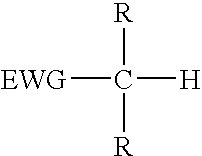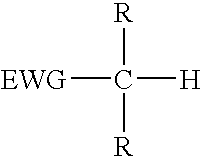Reagents for oligonucleotide cleavage and deprotection
a technology of oligonucleotide and reagent, which is applied in the field of synthetic oligonucleotide compounds, can solve the problems of loss of performance, mispriming or mutagenicity, and groups that are not compatible with deprotection reagents or automated synthesized synthesized devices, so as to minimize the contamination of synthesized oligonucleotides, convenient use, and convenient forma
- Summary
- Abstract
- Description
- Claims
- Application Information
AI Technical Summary
Benefits of technology
Problems solved by technology
Method used
Image
Examples
example 1
[0097] An oligonucleotide T.sub.8-Q-CDPI.sub.3:
[0098] 5' TTT TTT TT-Q-CDPI.sub.3 3' (SEQ ID. NO. 1)
[0099] was synthesized on the Model 3948 DNA Synthesizer (Applied Biosystems, Foster City, Calif.). Eight cycles of phosphoramidite chemistry was conducted with thymidine 3' phosphoramidite in a column containing 16 mg (200 nmoles) highly cross-linked polystyrene bead support loaded with 12 .mu.mole / gm of a linkage including quencher label Q and minor groove binder label CDPI.sub.3. The quencher label, Q, has the structure: 10
[0100] where X is the attachment site to a linkage. The minor-groove-binder label, CDPI.sub.3, has the following structure: 11
[0101] where X is the attachment site to a linkage.
[0102] The support was divided into two portions. The first portion was treated with 15% ethanolic ammonia (15:85 v / v EtOH:conc. NH.sub.4OH) for 2 hours at 55.degree. C. to effect cleavage and deprotection. The second portion was treated with 3% diethylmalonate (DEM) dissolved in 15% ethano...
example 2
[0104] An oligonucleotide T.sub.15-Q-CDPI.sub.3:
[0105] 5' TTT TTT TTT TTT TTT-Q-CDPI.sub.3 3' (SEQ ID. NO. 2)
[0106] was synthesized on the Model 3948 DNA Synthesizer (Applied Biosystems, Foster City, Calif.). Fifteen cycles of phosphoramidite chemistry was conducted with thymidine 3' phosphoramidite in a column containing 16 mg (200 .mu.moles) highly cross-linked polystyrene bead support loaded with 12 .mu.mole / gm of a linkage including quencher label Q and minor groove binder label CDPI.sub.3. The support was divided into two portions. The first portion was treated with 15% ethanolic ammonia (15:85 v / v EtOH:conc. NH.sub.4OH) for 2 hours at 55.degree. C. to effect cleavage and deprotection. The second portion was treated with 3% diethylmalonate (DEM) dissolved in 15% ethanolic ammonia (3:15:82 v / v / v DEM:EtOH:conc. NH.sub.4OH), for 2 hours at 55.degree. C. After cooling, an aliquot from each portion was analyzed by reverse phase HPLC. The portion cleaved and deprotected without DEM s...
example 3
[0107] Oligonucleotides labelled with a fluorescent dye (F=6-carboxyfluorescein) at the 5' terminus, and a quencher moiety (Q) and minor groove binder (CDPI.sub.3) at the 3' terminus:
1 5'F-CAG TCG CCC TGC C-Q-CDPI.sub.3 3' (SEQ ID. NO.3) 5'F-CTT CTT GCT AAT TCC-Q-CDPI.sub.3 3' (SEQ ID. NO.4)
[0108] were synthesized on a Model 3900 DNA Synthesizer (Applied Biosystems, Foster City, Calif.). Phosphoramidite chemistry was conducted with nucleoside 3' phosphoramidites, including A.sup.bz, G.sup.dmf, C.sup.bz and T, in a column containing 16 mg (200 nmoles) highly cross-linked polystyrene bead support loaded with 12 .mu.mole / gm of a linkage including quencher label Q and minor groove binder label CDPI.sub.3.
[0109] After each synthesis, the support was divided into four portions. Each portion was treated with a reagent containing 0%, 0.1%, 1% or 3% diethylmalonate (DEM) in 15% ethanolic ammonia (15:85 v / v EtOH:conc. NH.sub.40OH) for 2 hours at 65.degree. C. to effect cleavage and deprotecti...
PUM
| Property | Measurement | Unit |
|---|---|---|
| temperature | aaaaa | aaaaa |
| diameter | aaaaa | aaaaa |
| v/v | aaaaa | aaaaa |
Abstract
Description
Claims
Application Information
 Login to View More
Login to View More - R&D
- Intellectual Property
- Life Sciences
- Materials
- Tech Scout
- Unparalleled Data Quality
- Higher Quality Content
- 60% Fewer Hallucinations
Browse by: Latest US Patents, China's latest patents, Technical Efficacy Thesaurus, Application Domain, Technology Topic, Popular Technical Reports.
© 2025 PatSnap. All rights reserved.Legal|Privacy policy|Modern Slavery Act Transparency Statement|Sitemap|About US| Contact US: help@patsnap.com



